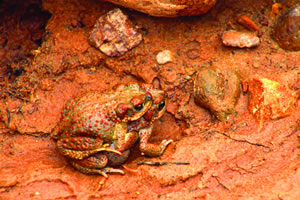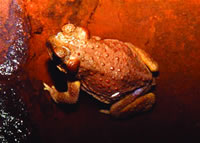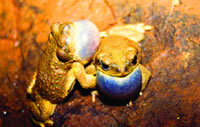It is late at night as I walk across the sandy dunes
to a desert pool. My headlamp illuminates the way,
highlighting obstacles like prickly pear cacti and
marauding scorpions.
I am pleased to find this desert pool full from the recent
rains. As I scout the edge of the pond for aquatic life,
I observe numerous tracks of coyote, kangaroo rat, lizard,
mule deer, and especially amphibians in the moist sand.
 But
it is the unmistakable, high-pitched trill of red-spotted
toads that is overwhelming evidence as to their presence.
These are the males, these desert singers, who are calling
for the females to join them at this particular breeding
site. Perhaps triggered by the recent rains, these toads
realize that their window of opportunity is narrow; it
won’t take long for this ephemeral pool to become
a dry, dusty pothole. But
it is the unmistakable, high-pitched trill of red-spotted
toads that is overwhelming evidence as to their presence.
These are the males, these desert singers, who are calling
for the females to join them at this particular breeding
site. Perhaps triggered by the recent rains, these toads
realize that their window of opportunity is narrow; it
won’t take long for this ephemeral pool to become
a dry, dusty pothole.
When I reach the sandstone edge of the pool, I see many
of these small, warty toads with pointed snouts. The
chorusing stops, but only for a few moments. Soon one
starts, then another, then another, until the blackness
seems pierced by trilling.
I unload my camera gear and set up the tripod. I use
a macro lens and have to watch where I place my camera.
I carefully move about the pool and sandstone edge, avoiding
the toads that seem reluctant to move. Not that I can
blame them.
A red-spotted toad (Bufo punctatus) is a small, compact
toad, 1½- 3” long. Their squat bodies are
grayish to olive to brownish in color and are covered
with small reddish or orangish warts called tubercles.
Often their coloration matches the surrounding substrate.
Behind their eyes are two small, rounded glandular structures
called parotoid glands. On some toads these may emit
a potent toxin, although these red-spotted toads produce
little or no toxins.
The common name and species name, punctatus (which means “spotted”)
are derived from the reddish warts that cover the body.
Bufo is Latin for “toad” and in Spanish these
toads are called sapo.
 The
red-spotted may be found from sea level up to 7,200’ in
elevation. Though the breeding season is from April to
September, elevation and rainfall influence that period.
Spring or summer rainstorms that are of sufficient duration
awaken these slumbering amphibians, and the males leave
their underground chambers and start to chorus. The
red-spotted may be found from sea level up to 7,200’ in
elevation. Though the breeding season is from April to
September, elevation and rainfall influence that period.
Spring or summer rainstorms that are of sufficient duration
awaken these slumbering amphibians, and the males leave
their underground chambers and start to chorus.
The advertisement call is a high pitched trill that lasts
from 6-10 seconds and the male’s dusky vocal sac
expands with the call. If the males clasp another male
or an unreceptive female, they emit a release call that
sounds like a chirp followed by a short trill. A female
carries developed eggs that need external fertilization.
When the pair joins together, the embrace is called amplexus.
She releases her eggs one at a time, not in long strings,
and is the only North American toad to do so. The male
fertilizes the eggs, which are enveloped in a gelatinous
coating to protect the embryo. The eggs sink to the bottom
of the pool and will hatch in only a few hours.
 Time
and predators are the enemies of the red-spotted toads.
Although coyotes, foxes, raccoons, salamander larvae,
and some aquatic invertebrate larvae predate on the tadpoles,
it is shortness of time that rushes these tadpoles through
their developmental stages. The tadpoles take between
40 and 60 days to transform into adults. Sometimes their
natal pool will dry out, stranding the tadpoles like
whales on a beach. Time
and predators are the enemies of the red-spotted toads.
Although coyotes, foxes, raccoons, salamander larvae,
and some aquatic invertebrate larvae predate on the tadpoles,
it is shortness of time that rushes these tadpoles through
their developmental stages. The tadpoles take between
40 and 60 days to transform into adults. Sometimes their
natal pool will dry out, stranding the tadpoles like
whales on a beach.
The red-spotteds ability to lose 40% of its body water
and still survive is an adaptation that allows the toad
to stray from water or to seek new habitats. Small amounts
of water, even dew, may be absorbed through a thin, translucent
pelvic patch located behind the legs and extending up
onto the abdomen. This allows them to absorb moisture
and exchange electrolytes through their underside while
in contact with damp ground.
When I am done photographing these toads, I pack my gear
and head back to the car. Above me the star-studded night
sky lacks an amphibious constellation, but the chorusing
toads remind me that this night belongs to them.
|